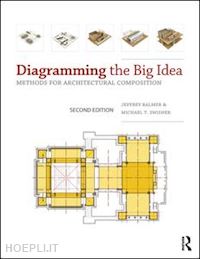Part I: Setting the Stage 1. Introduction Read me first! Why read this book? What is architecture? Organization, order, composition Utility, function, purpose Measure & matter Design & method Strategies & tactics The structure of the narrative The sequence of the chapters The role of precedents The point of departure Glossary of terms Details 1 - Order & Measure From the divine to the secular Demonstration 1.1 Organizational figures Demonstration 1.2 The courtyard schema Demonstration 1.3 Courtyards as objects Demonstration 1.4 Additional courtyard schemata 2. Sorting through ideas Diagrams as method Diagram types Diagramming & design education Learning diagrammatic form Gestalt sub–categories The diagram & visual order Our purpose Glossary of terms Details 2 Indigenous diagrams Demonstration 2.1 Diagrams & contexts Demonstration 2.2 Plan as diagram 3. Order First On order On measure Dividing the square Rules of engagement Positive & negative space Order & the orthogonal Glossary of terms Details 3 - Order, Orientation, Orthogonal The gridded city Demonstration 3.1 Gestalt defined Demonstration 3.2 Gestalt readings of basic form Part II: The First Project Set 4. Design & drawing fundamentals On drawing Relevance to design Deriving order in drawing Exercises in relational geometry Defined & implied space Analyzing the composition Three variant compositions Observing contrast, repetition, alignment & proximity The variations considered General observations Motif, pattern & theme Defined fields Sorting through results Implied fields Adding fields Combining fields Summary Glossary of terms Details 4 - The Courtyard Figure–ground & solid–void Demonstration 4.1.1 Figures & field in variation Demonstration 4.1.2 Variation & elaborations Demonstration 4.1.3 Variation & elaborations Demonstration 4.2 Further variations Demonstration 4.3 Contrast, repetition, alignment & proximity The second project set 5. Building on proportion Object on a field A figure in the relational field Looking at the groups Selecting & analyzing an aggregate composition Adding to the quadrants Two elements Refining the figures Observing the new figures Observing the new group Glossary of terms Details 5 - Figures & Fields Objects & space Demonstration 5.1 Regulating lines dividing space Demonstration 5.2 Figures & their construction Demonstration 5.3 Field, grain & path 6. Conventionos in Design Drawing in the third dimension Adding fields & overhead planes Turning the grid Reading the section A final model Glossary of terms Details 6 - Axis & Path Lines, planes & volumes Part III: The third project set 7. Starting in three dimensions Design on a grid The site Three figures Spatial models Volume, form & space: an example Visualizing connection with constructed axes The gestural nexus Spatial hierarchy: field grain & path Clarifying plan elements The new grid Strategy set Tactical definitions & variations A final remark Glossary of terms Details 7 - Spatial Systems Frames, planes & cells Demonstration 7.1 Axial volumes Demonstration 7.2 Additional composition models 8. Models & diagrams More complex approaches to strategies Strategy definitions Tactical themes & variations Tactics expanded – procedure & results Three–dimensional diagrams Combined diagram models Planning the final model Fragments models The final model Conclusion Glossary of terms Details 8 - Treshold & Boundary Containment & connection Demonstration 8.1 Axial volumes Demonstration 8.2.1 Alternate tactical diagrams Demonstration 8.2.2 Additional hybrid tactical diagrams Demonstration 8.3 Demonstration model Demonstration 8.4 Demonstration drawings Demonstration 8.5.1 Assembly images Demonstration 8.5.2 Alternate model #1 Demonstration 8.5.3 Alternate model #2 Part IV: Precedents 9. Precedent diagrams in two dimensions Introduction Two concepts Two expressions Two dimensions Two projects House with Three Courts The Danteum Glossary of terms Details 9 - What an Architect Sees Margaret Esherick house 10. Precedent diagrams in three dimensionos Introduction Representing the third dimension Phillips Exeter Academy Library Unity Temple Diagram as generator Glossary of terms Details 10 - The Language of ColorColor as a subject Glossary of color terms Part V: Resources Master glossary of terms Index











